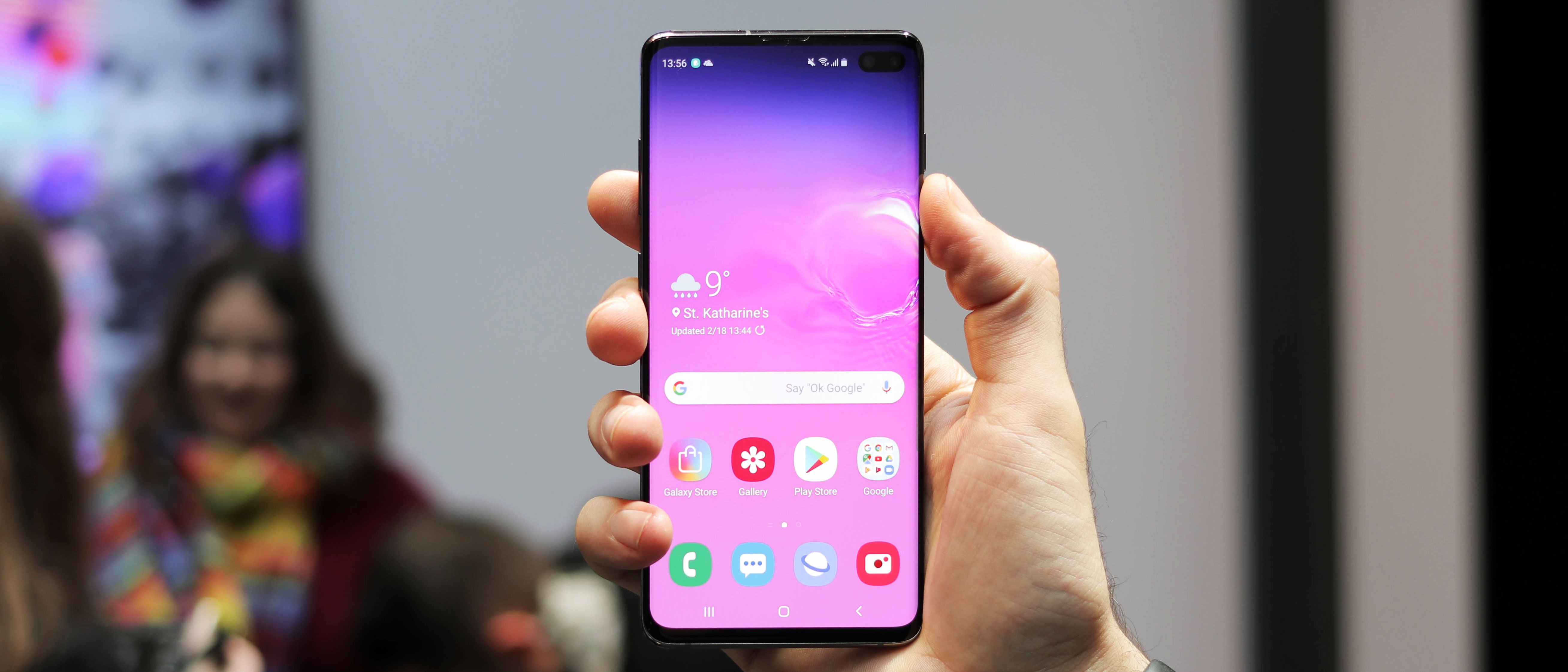TechRadar Verdict
The Galaxy S10 Plus is Samsung's new 'everything phone' for 2019, helping disrupt the sameness of the last few generations of Samsung handsets. Its 6.4-inch screen is so big it displaces the front camera, while its triple-lens rear camera can take ultra-wide photos. And though you can’t see them, the in-screen fingerprint sensor is hidden feature for you, while Wireless PowerShare is a perk for your battery-drained friends. It has a lot of nifty features – just know Samsung is asking for a lot of money, too.
Pros
- +
Excellent screen
- +
In-screen fingerprint sensor
- +
Wireless PowerShare
- +
Strong battery life
Cons
- -
Expensive
- -
Slippery design
- -
Camera tech similar to S9
Why you can trust TechRadar
The following is the localized review for the Middle East. Click here to read the global review of the Samsung Galaxy S10 Plus.
The Samsung Galaxy S10 Plus is the new, almost-everything-included Samsung phone that you really want, if you can afford it – and can wrap your hands around its massive display.
We were immediately drawn to it as the bigger and better version of the Galaxy S10 and cheaper Galaxy S10e. There's a lot to like about the Samsung Galaxy S10 Plus, and very little to dislike.
The Galaxy S10 Plus redefines what a 'phablet' is in 2019, with a 6.4-inch edge-to-edge screen and Samsung's next-generation Infinity-O display, with a 'punch-hole' design for the front-facing cameras.
- Read our hands-on Samsung Galaxy S10 review
- Read our hands-on Samsung Galaxy S10e review
- Read our hands-on Samsung Galaxy S10 5G review
- And here's all you need to know about the Samsung Galaxy Fold
Watch our Samsung Galaxy S10 Plus unboxing video below
A post shared by TechRadar Middle East (@techradarme)
A photo posted by on on Feb 20, 2019 at 1:57pm PST
With a 93.1% screen-to-body ratio, the pixels now stretch from the small top speaker down to the thin bottom chin, and spill over the curved edges to the left and right.
There's more hidden under the glass too, with an ultrasonic fingerprint sensor on the front, a large 4,100mAh battery and Samsung's new Wireless PowerShare feature on the rear, allowing you to top-up other wireless charging devices.
The cleaner-looking back of the Galaxy S10 Plus features a triple-lens camera with a small camera bump. It takes normal, telephoto, and new ultra-wide photos, with the intention to help you capture more of what's in front of you without requiring you to back up.

Samsung Galaxy S10 Plus price and release date
The Samsung Galaxy S10 Plus release date is March 8, but pre-order began on February 20, giving prospective owners plenty of time to make their intentions known… and to save up a little bit of extra cash.
In the last couple of years, customers who have pre-ordered a Samsung phone have received units a day or two earlier than the retail availability so if you have decided to purchase the Galaxy S10 Plus, we highly recommend pre-ordering it. Plus you also get the Galaxy Buds for free!
It starts at AED 3,599 / SAR 3,599 / QAR 3,599 / KWD 300 / BHD 382 / OMR 380 for the 8GB of RAM with 128GB of storage model. That sits right between the Galaxy Note 9 was was AED/SAR 100 more at launch and the Galaxy S9 Plus which was AED/SAR 100 cheaper.
Want more internal storage? You can upgrade to 512GB, which will set you back AED 4,499 / SAR 4,499 / QAR 4,499 / KWD 375 / BHD 482 / OMR 475 and comes back with premium ceramic instead of glass.
There’s a third S10 Plus variant – one Samsung calls the 'Ultimate Performance Edition'. It packs in a mammoth 12GB of RAM and huge 1TB of storage, and comes with an equally monstrous price tag of AED 5,799 / SAR 5,799 / QAR 5,799 / KWD 485 / BHD 622 / OMR 610.
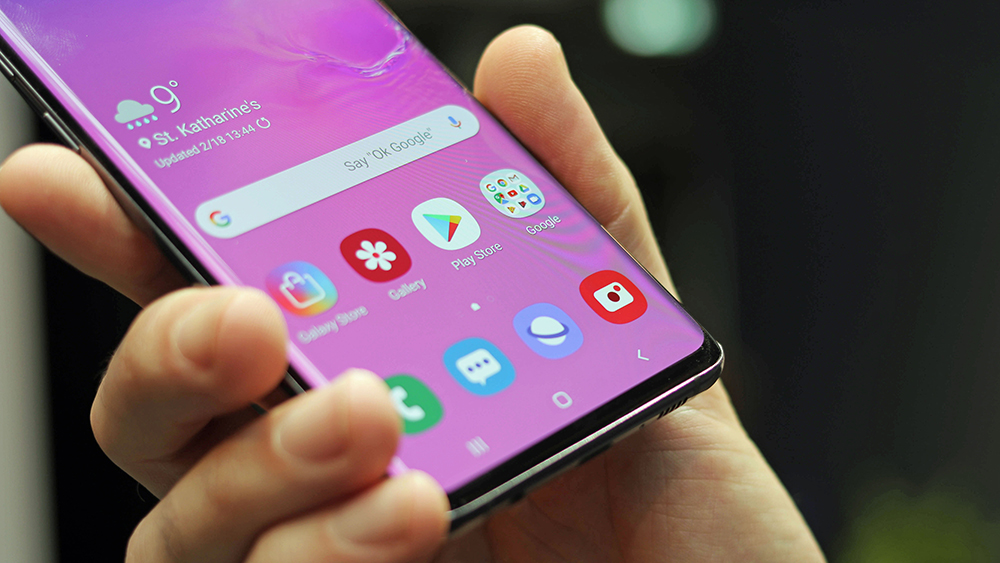
This special-edition variant doesn’t appear to be as widely available and pre-orders have already sold out, so you may need to do a little bit of hunting to find it.
While the Samsung Galaxy S10 Plus price has increased, it’s worth noting that you're now getting a base storage of 128GB compared to 64GB on the S9 Plus last year. Also, even with an AED 100 price hike, the Galaxy S10 Plus remains cheaper than its biggest rival, the iPhone.
The price of the 128GB Plus, with a microSD card slot for expandable storage, is still lower than the smaller 5.8-inch iPhone XS with 64GB of storage and no microSD card slot which costs AED 4,299. The larger iPhone XS Max starts at AED 4,649, again with half the storage Samsung is offering in its base model.
Samsung is offering pre-order bonuses with both the Galaxy S10 and Galaxy S10 Plus. In the UAE, reserving either phone before the official release dates gets you a free pair of Galaxy Buds true wireless earbuds worth AED 479 with the 12GB version. If you chose the 512GB or 1TB version of the Galaxy S10 Plus, you get the Galaxy Watch in 42mm or 46mm respectively for free.
Early adopters with plenty of money might also hold out for the true innovation of the foldable Samsung Galaxy Fold, which will be available from April 26. Samsung's first foldable phone is expensive, but at least it’s cheaper than the Huawei Mate X.
Display
Weight: 175g
Dimensions: 157.6 x 74.1 x 7.8mm
OS: Android 9
Screen size: 6.4-inch
Resolution: QHD+
CPU: Octa-core chipset
RAM: 8GB/12GB
Storage: 128/512GB/1TB
Battery: 4,100mAh
Rear camera: 16MP + 12MP + 12MP
Front camera: 10MP + 8MP
The 6.4-inch Super AMOLED display on the Samsung Galaxy S10 Plus makes this the biggest S phone screen to date, bigger than 5.8-inch Galaxy S9 Plus and matching the Galaxy Note 9 screen size. It's also a lot better.
The main draw for us is the 93.1% screen-to-body ratio, as Samsung has found a way to fit more pixels across a tighter body, which also means a reduction in the size of the already-slender bezels above and below the display.
Its standout screen size is down to Samsung's new Infinity-O display. The South Korean firm has avoided using a notch cut-out across its new flagship range by opting for a laser-cut hole in the top-right corner.
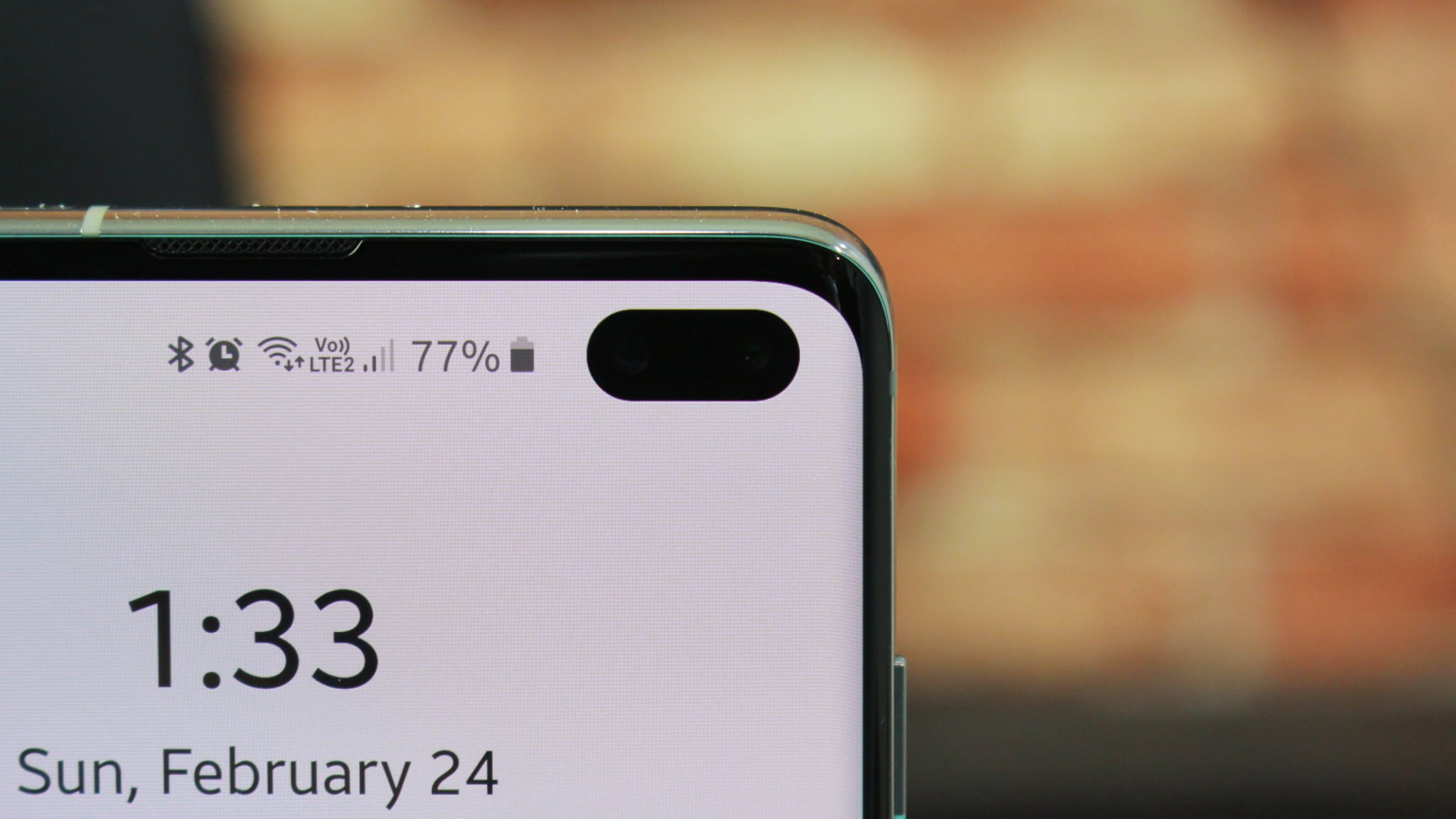
This 'punch-hole' display is officially a trend, but Samsung's biggest phone includes two front-facing cameras, not one, with the second RGB camera used to take better portrait selfies than the single-lens front-facing Galaxy S10 and S10e cameras. It means the punch-hole on the S10 Plus takes up a little more space than on other handsets.
It’s bigger than some single camera notches and punch-holes, but we’ve not found it any more distracting, and it allows Samsung more screen real estate to play with. That’s the real benefit: fitting more small notification icons across the top, like Wi-Fi, Bluetooth, and mobile signal, and the all-important battery life percentage we can’t live without.
It's worth noting that the two front cameras sit in line with the notification bar, so don't get in the way at all when it comes to general usage (web browsing, social media, emails and so on), while a black bar is applied to this end of the screen when you’re gaming or watching movies, effectively making it disappear.
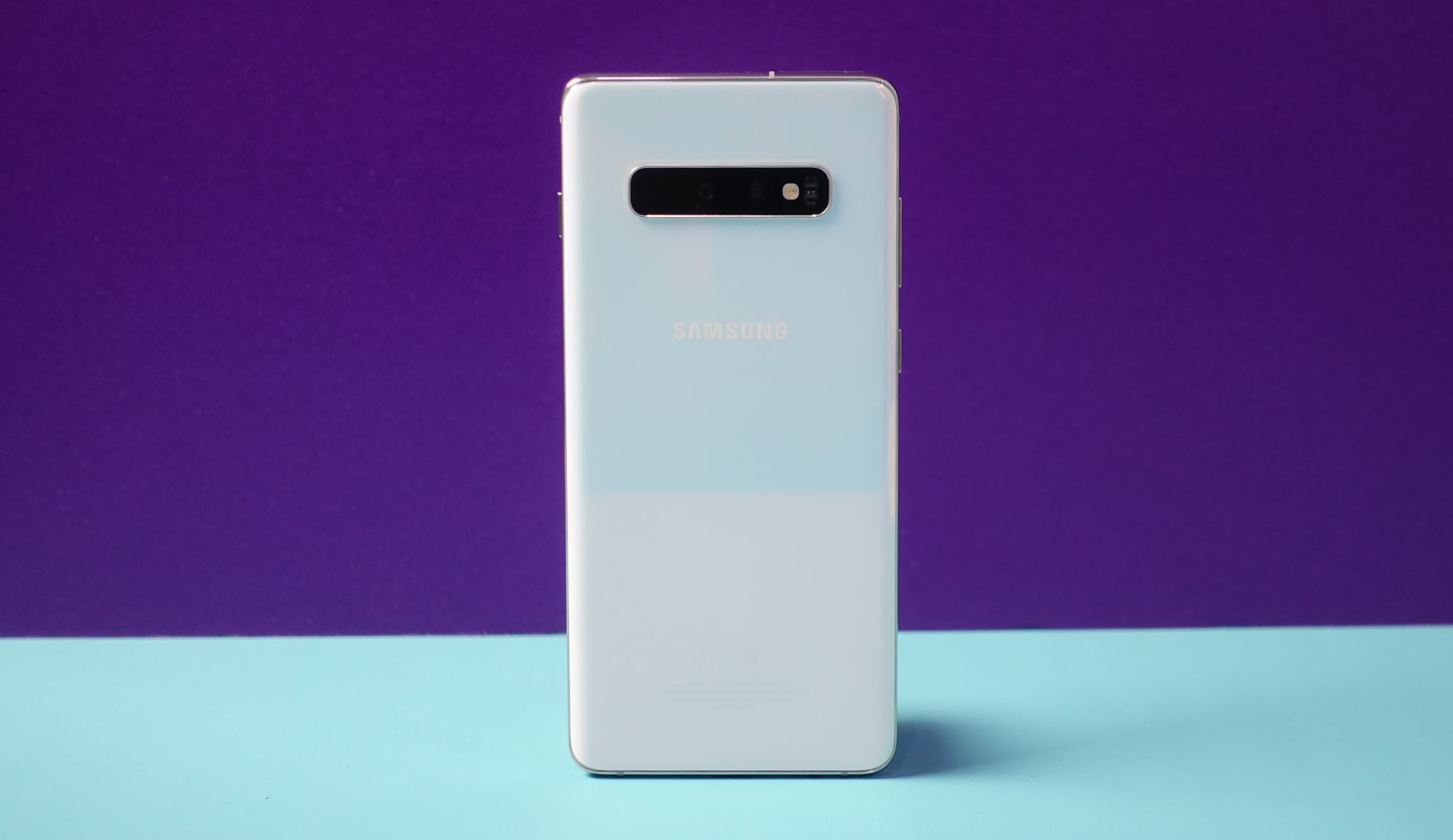
The Galaxy S10 Plus screen boasts a 1440 x 3040 QHD+ resolution, which is stretched over the tall 19:9 aspect ratio and provides a pin-sharp 526ppi pixel density – in short, this is a big, highly detailed display.
By default the screen resolution is actually set to Full HD+ (2280 x 1080) – something Samsung has done on its last few flagships in an effort to conserve battery power.
For the most part this resolution is all you need, providing clear and detailed images and text, but it can adapt automatically when you load up a 4K movie or graphically intensive game. That’s a smart way to give us a better picture without wasting juice.
The Samsung Galaxy S10 Plus is also the first phone (along with the Galaxy S10) with HDR10+ support for superior contrast and color, an important perk if you’re a movie watcher on your phone – an idea which isn’t so crazy here, since the screen size is close to that of a small tablet.
Other screen attributes include enhanced brightness for better outdoor visibility and Samsung’s familiar elegantly curved edges, letting pixels spill over the sides.
There’s one drawback to Samsung chipping away at the bezel: we found our encroaching palms making more false touches on this sensitive screen (especially when typing), often flipping our on-screen keyboard back-and-forth between letters and numbers to output a bunch of gobbledygook in embarrassing messages. iPhone owners accustomed to more otherwise-ugly bezel and better palm rejection software may find it tough to switch for this reason.
You'll still find a small bezel outline at the top and bottom of this phone – it's less bezel rather than bezel-less. Samsung hasn't worked out how to do away with the top speaker in this year’s handset – although we think that'll be the next thing to go, in 2020 – while the bottom has a thinner, but noticeable, chin. If anything, that may be more distracting than the punch-hole.
The Infinity-O display is Samsung's new look for 2019, and it’s enough of a change if you've been demanding something new. It looks fantastic, with bright, colorful reproduction making the best of images, icons, apps, games and video.
Design
Aside from the new screen, the design of the Samsung Galaxy S10 Plus looks familiar at first sight. However, you'll find subtle improvements, and surprises new and old.
Its aluminum frame is thinner than that of the S9 Plus, and still sandwiched between smooth glass – in most versions. Everything on the standard S10 Plus is covered in Gorilla Glass 6, front and back, while the 512GB and 1TB versions are backed by ceramic in either white or black.
Meanwhile the standard glass version – the one most people will likely buy – comes in ‘Prism’ white, black and green. We got the Prism model as our review device that has 128GB of storage.
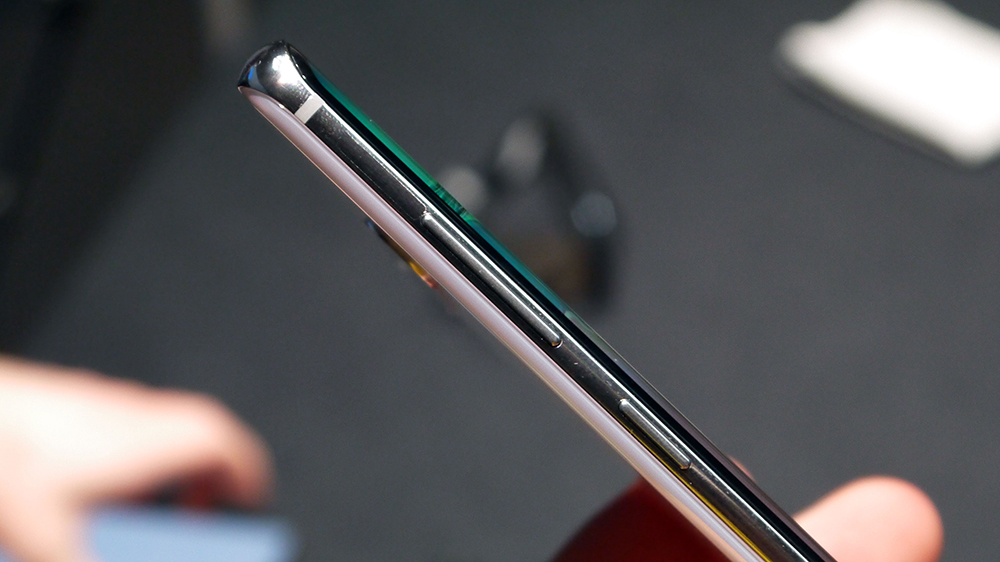
The back of the Galaxy S10 Plus almost flush, with a triple-lens camera array that has a subtle camera bump outlining it, and you won't be able to tell where the reverse wireless charging module is located below this.
The camera’s centralized position on the rear of the phone, rather than the top-right corner placement common on many smartphones, means it sits nicely on a surface and doesn’t rock on an angle. It’s a minor point, but we appreciate the balanced stance the S10 Plus has.
We also appreciate the cleaner look of the S10 Plus – it’s a smarter, more polished appearance.
The fingerprint sensor performs an invisible trick, too, and it's one you'll want to show off. After a two-year hiatus, Samsung's fingerprint sensor returns to the front of its flagships, but this time it’s embedded under the glass of the display, thanks to Qualcomm's ultrasonic fingerprint technology.
The 3D scan of your fingerprint is said to allow for more accurate unlocks, and be more secure than the optical scanners on the likes of the Huawei Mate 20 and OnePlus 6T.
One downside to the fingerprint scanner in the Galaxy S10 Plus is speed – it's not as quick to recognize your print as optical readers located outside of a display.
You're still looking at no more than a second from placing your finger down to unlocking the S10 Plus, but if you're coming from a device with an optical reader you'll likely notice the slight delay.
You need to apply more pressure on the in-display fingerprint scanner than you would on an optical one, and you'll need to put your finger in the right place, otherwise it won’t work – there’s a helpful fingerprint icon on the screen showing you where your digit needs to go.
We experienced some failures due it incorrect placement at first, and with no physical ridge to guide our finger we don't expect to eliminate failures completely. But in time, we went from a first-time recognition success rate of 80% to a 95% success rate. Some of that was an update and some of it came down to getting used to the invisible sensor location.
These issues can be mitigated if you opt to also set up face unlock, which we found could recognize us faster than the fingerprint scanner – the only issue here is that you have to be looking at the S10 Plus to unlock it and it’s less secure.

The Samsung Galaxy S10 Plus measures 157.6 x 74.1 x 7.8mm, roughly the dimensions of the S9 Plus – the new phone is a bit shorter, a tad wider, and noticeably thinner and lighter – and feels better in the hand than the physically bigger Note 9 with its 83.4% screen-to-body ratio.
Indeed, the Galaxy S10 Plus is surprisingly easy to hold in the hand for a ‘Plus’-sized handset. Those with smaller palms will still find it huge, but the reduction in bezels and the curved edges mean it nestles nicely, despite the size of the screen.
The glass and metal finish offers very little in the way of grip though, and we found ourselves employing two hands more frequently than with most phones to ensure a secure hold during tasks such as typing. You’re going to want to buy a Samsung Galaxy S10 Plus case before you walk out of the store with this one.
We also found the power/lock key on the right side of the S10 Plus a little high up to consistently hit with ease, and we sometimes had to shimmy the phone in our hand to be able to reach it.
On the left side the volume rocker sits above a dedicated key for Samsung's smart assistant, Bixby. Press this, and you'll launch the assistant immediately, giving you quick access to voice commands and the Bixby Today screen. Unfortunately, it’s a little too easy to mistake this AI key for the volume-down button.
Unchanged since the first S phone a decade ago is the presence of a 3.5mm headphone jack, which returns on the bottom of the phone alongside the USB-C port.
Samsung remains one of the few phone makers that hasn’t ditched the standard jack, and what’s impressive is that it’s also trying to sell its wireless Galaxy Buds without axing this venerable feature. It’s a show of strength that the company went with a consumer-friendly design choice here.

Abbas has been living and breathing tech before phones became smart or clouds started storing data. It all started when he got his very first computer- the Sinclair ZX Spectrum. From computers to mobile phones and watches, Abbas is always interested in tech that is smarter and smaller because he believes that tech shouldn’t be something that gets added to your life- it should be a part of your life.
